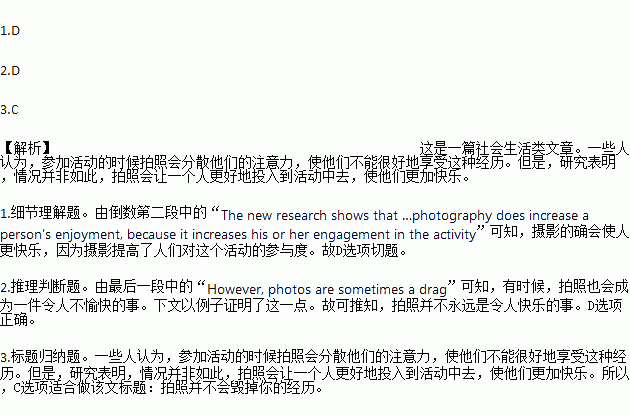题目内容
The next time your friends roll their eyes when you’re snapping a selfie (自拍照) or taking a photo of your dessert, tell them that photographing everyday things can actually make people happier.
In a study of more than 2,000 people, researchers found that people who took photos of their experiences, whether they were walking through a museum or going on a city bus tour, had a better time overall compared with those who didn’t.
During each of the study’s nine experiments, people were asked to either take photos or give up photography during an everyday activity, such as eating a meal. In nearly every experiment, the group that took photos showed higher levels of enjoyment.
The finding might not sound terribly surprising. After all, Facebook members upload about 2 billion photos daily, and Instagram users upload about 80 million photos every day. But some people argue that taking photographs can distract (分散注意力) themselves from enjoying an experience while it’s happening.
The new research shows that it isn’t the case and that photography does increase a person’s enjoyment, because it increases his or her engagement in the activity. For example, in one experiment, people toured a museum while wearing glasses that tracked their eye movements. The group that took photos spent more time looking at the artifacts than those who didn’t.
However, photos are sometimes a drag. For instance, if the camera is difficult to carry, it might not bring enjoyment to a person. And in some cases, photography can make situations unpleasant. For example, when people in the study took a virtual safari (游猎) and watched some lions attacking a water buffalo, the people who took photos of the bloody event were reported to have a lower enjoyment of the activity than those who didn’t, the researchers said.
1.Why does taking photos increase enjoyment?
A. People can share their photos on Facebook. B. People have more time to look at the objects to be photographed.
C. Some photos may end up as valuable artifacts. D. Photography gets people more involved in the activity.
2.What can we infer from the last paragraph?
A. Photography sometimes can be dangerous.
B. Photography requires more courage to do.
C. Photography is an unpleasant process.
D. Photography isn’t fun all the time.
3.Which of the following is closest to the main idea of the text?
A. Photography helps you appreciate people around you.
B. Snapping a selfie is a symbol of self-confidence.
C. Taking photos doesn’t ruin your experience.
D. The photo-taking process is a mental choice.

